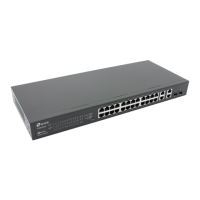131
be Standard-IP ACL, and 200-299 must be Extend-IP ACL.
Command Mode
Global Configuration Mode
Example
Create a MAC ACL whose ID is 20:
TP-LINK(config)# acl create 20
acl rule mac-acl
Description
The acl rule mac-acl command is used to add MAC ACL rule. To delete the
corresponding rule, please use no acl rule mac-acl command. MAC ACLs
analyze and process packets based on a series of match conditions, which can
be the source MAC addresses, destination MAC addresses, VLAN ID, and
EtherType carried in the packets.
Syntax
acl rule mac-acl {acl-id} {rule-id} [op { discard | permit }] [[smac source-mac]
{smask source-mac-mask}] [[dmac destination-mac] {dmask
destination-mac-mask}] [vid vlan-id] [type ethernet-type] [pri user-pri] [tseg
time-segment]
no acl rule mac-acl {acl-id} {rule-id}
Parameter
acl-id —— The desired MAC ACL for configuration.
rule-id —— The rule ID.
op —— The operation for the switch to process packets which match the rules.
There are two options, discard and permit. Discard means discarding packets,
and permit means forwarding packets. By default, the option is permit.
source-mac —— The source MAC address contained in the rule.
source-mac-mask —— The source MAC address mask. It is required if you
typed the source MAC address.
destination-mac —— The destination MAC address contained in the rule.
destination-mac-mask —— The destination MAC address mask. It is required
if you typed the destination MAC address.
vlan-id —— The VLAN ID contained in the rule, ranging form 1 to 4094.
ethernet-type —— EtherType contained in the rule, in the format of 4-hex

